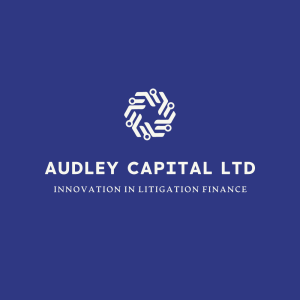
Let's think about what we want to achieve here as the header. It reads more like an info article than us offering an investment consultancy service
Audley Capital Ltd. brings together a team of litigation funding experts with a long track record of working with funders, law firms, and claim originators, bringing investment capital, legal expertise, and deal flow together in one place. Much of our time is spent working with investors seeking new ways of investing capital to provide risk-graded commercial returns while benefitting society in general. Social justice and social impact are at the heart of why Audley was established in late 2022.
Litigation funding, also known as legal funding or litigation finance, is a process where a third-party funding company provides financial assistance to individuals or businesses involved in a legal dispute. This funding arrangement allows plaintiffs to pursue their legal claims without incurring the upfront costs typically associated with litigation. Here’s how litigation funding generally works:
- Evaluation: The plaintiff or their attorney approaches a litigation funding company and provides details about the case, including the nature of the dispute, the likelihood of success, and the potential damages or settlement amount.
- Due Diligence: The litigation funding company evaluates the case to assess its merits, potential risks, and chances of success. This may involve reviewing legal documents, consulting with experts, and analysing the legal strategy.
- Funding Agreement: If the litigation funding company determines the case has strong prospects, it may offer financial assistance. The funding agreement, outlining the terms and conditions of the funding arrangement, is then negotiated and signed between the funding company and the plaintiff.
- Financial Assistance: Once the funding agreement is in place, the litigation funder provides the approved amount of funding to the plaintiff. The funds can cover various litigation-related expenses, such as attorney fees, court costs, expert witness fees, document production, and other litigation expenses.
- Repayment: In most cases, litigation funding is non-recourse, meaning the plaintiff is only obligated to repay the funding if they win the case or reach a favourable settlement. If the case is unsuccessful, the plaintiff typically does not have to repay the funding. However, it’s essential to review the terms of the funding agreement carefully, as repayment obligations may vary.
- Settlement or Judgment: If the plaintiff succeeds in their legal claim, they receive the settlement amount or judgment awarded by the court. In such cases, the litigation funder is entitled to receive repayment according to the agreed-upon terms, including a predetermined share of the settlement or a multiple of the funding amount.
It’s worth noting that litigation funding is subject to various regulations and legal frameworks, which may vary across jurisdictions. Additionally, the specific terms and conditions of funding agreements can differ between litigation funding companies and cases. It’s crucial for plaintiffs to consult with legal professionals and carefully review the funding agreement before entering any litigation funding arrangement.
Litigation funding promotes social justice by providing access to justice for individuals and groups who may otherwise not have the financial resources to pursue legal action. It can level the playing field by allowing underprivileged or marginalised individuals and communities to seek compensation or fight for their rights against powerful entities.
How litigation funding can create power for social change:
- Access to Legal Representation: Litigation funding can help bridge the gap between those who can afford legal representation and those who cannot. It provides financial resources to individuals and organisations to hire competent lawyers and pursue their legal claims, irrespective of their financial status.
- Equalizing Power Dynamics: Individuals or small organisations may often be pitted against large corporations or institutions with significant resources. Litigation funding can help balance the power dynamics by enabling the weaker party to mount a solid legal defence or initiate legal action, thus holding powerful entities accountable.
- Public Interest Litigation: Litigation funding can support public interest litigation (PIL) cases that address more significant social issues or seek systemic change. These cases often involve advocating for the rights of marginalised communities, environmental protection, human rights, and other social justice causes. By financing such cases, litigation funders contribute to pursuing justice beyond individual interests.
- Deterrence and Accountability: The availability of litigation funding can deter unlawful practices or behaviours. Knowing that underprivileged individuals or groups have the financial means to pursue legal action can encourage potential wrongdoers to think twice before engaging in unjust activities. This, in turn, promotes greater accountability and fairness within society.
- Precedent-Setting Cases: Litigation funding can support landmark cases, establish legal precedents, or influence policy changes. By funding high-impact cases, litigation funders can help shape the legal landscape and contribute to social justice reforms.
It’s important to note that while litigation funding can have positive implications for social justice, it also raises ethical considerations and potential challenges. For example, there may be concerns about funders’ influence on the direction or outcome of cases. Transparency and ethical guidelines are crucial to ensure that litigation funding remains aligned with the pursuit of justice and the public interest.
The Exponential Growth of Litigation Funding as an Alternative Asset Class
Introduction
Litigation funding has witnessed remarkable growth in recent years, transforming into a prominent alternative asset class sought after by investors worldwide. As a form of third-party financing for legal disputes, litigation funding offers an attractive investment opportunity with potential significant returns. This article delves into the factors driving the exponential growth of litigation funding as an alternative asset class and explores its benefits for investors.
Diversification and Uncorrelated Returns
Litigation funding offers investors a unique opportunity to diversify their portfolios by adding an asset class largely uncorrelated with traditional financial markets. The performance of litigation investments is driven by the outcomes of individual legal cases, which are independent of economic cycles and market fluctuations. As a result, litigation funding can act as a hedge against market volatility, offering potential returns not tied to the performance of stocks, bonds, or real estate.
High Return Potential
One of the primary attractions of litigation funding as an alternative asset class is its potential for high returns. Successful litigation cases can yield substantial financial gains through settlement agreements or court-awarded damages. Litigation funders typically negotiate favourable terms, such as receiving a portion of the recovered amount or a multiple of their initial investment. These potential returns, often exceeding traditional investment opportunities, have attracted many investors seeking above-average profits.
Risk Mitigation and Portfolio Protection
Litigation funding provides investors a unique way to mitigate risk and protect their portfolios. By investing in a diverse portfolio of legal cases, investors can spread their risk across multiple claims, reducing the impact of any individual case outcome. This risk diversification approach particularly appeals to institutional investors and high-net-worth individuals keen to safeguard their capital and mitigate potential losses in a volatile investment landscape.
Additionally, the “non-recourse” nature of litigation funding further shields investors from downside risk. In the event of an unsuccessful case, investors are generally not responsible for covering the legal costs or repaying the funding amount. This structure allows investors to participate in the potential upside of litigation without bearing the entire financial risk, thus enhancing the attractiveness of litigation funding as an alternative asset.
Alignment of Interests and Expert Due Diligence
Litigation funders have a vested interest in the success of their investments, as they typically earn a percentage of the recovered funds. This alignment of interests between the funder and the claimant enhances the due diligence process and ensures that only strong and meritorious cases are pursued. Litigation funders conduct thorough assessments of potential claims, evaluating the likelihood of success and the possible damages or settlements. Their expertise in analysing legal and financial factors helps investors make informed decisions, minimising the risk of investing in weak or uncertain cases.
Market Maturity and Increased Awareness
The growing maturity of the litigation funding market has played a significant role in its exponential growth as an alternative asset class. As the industry has evolved, best practices, regulations, and standardised funding agreements have emerged, providing investors with greater confidence and transparency. This increased market maturity and the success stories of high-profile cases have garnered attention and raised awareness among investors, attracting new capital to the sector.
Litigation funding has rapidly evolved into a thriving alternative asset class, offering investors the potential for high returns, diversification, risk mitigation, and alignment of interests. As investors seek non-traditional investment opportunities and look beyond traditional asset classes, litigation funding stands out as a compelling option. With the market’s continued growth, increased awareness, and a track record of successful investments, litigation funding is poised to maintain its exponential growth trajectory as an attractive alternative asset class.
We need to think what we want to say here
Your content goes here. Edit or remove this text inline or in the module Content settings. You can also style every aspect of this content in the module Design settings and even apply custom CSS to this text in the module Advanced settings.
